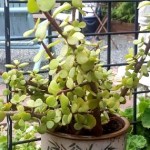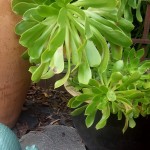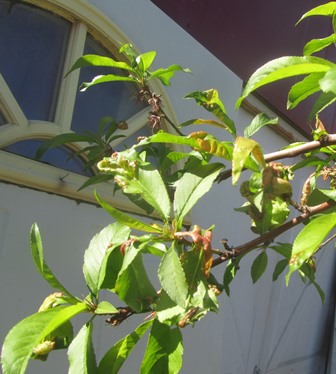Succulents, Easy to Grow Plants for Holiday Gift-Giving
It’s winter, the time when many plants (including succulents) go dormant. But that doesn’t mean you cannot propagate new plants from your existing succulents. You don’t need any special tricks to get a cutting to root (you can often just pluck a fleshy leaf or stem and ease it into soil or suspend in water and it will root). However, root hormone powder is a great way to get roots started on just about everything, including succulents.
Root hormone powder makes short work of getting new roots on your succulent cutting. You just dip the cleanly cut edge of a fleshy leaf into the powder and shallowly plant in a succulent planting mix or potting soil (a half leaf or one not cleanly detached should not be used). Gently water directly, give lots of light exposure, rotate often, and mist regularly to keep the soil moist and the plant happy.
Succulents planted in attractive pots make lovely living gifts for the holidays. For friends with garden windows that offer lots of light, why not group three pots of succulents on a tray? Find a variety of pots and succulents in a diy center or local nursery.
Diverse succulents in a range of sizes (tall, medium, and short heights) are particularly striking when grouped together a a round shallow pot or long rectangular container.
- Combine different types of succulents in a single pot
They’re not just for winter holiday gift-giving, succulents are appreciated all year long. They love light, but not a blazing hot sun. They appreciate a soak and dry method of watering. And some prefer the outdoors. Some even reward your efforts with a bloom. To give a succulent as a holiday gift, all you need is a healthy plant in a pretty pot. Just add a ribbon and a gift card. The plants are so easy to grow, propagate, and care for, that everyone loves them.
_____________________________________________________________________________
If you enjoy reading about gardening, country living, and health and wellness, check out my various books on these topics. They include THE SELF-CARE PLANNER, HOW TO LIVE WITH INTENTION, MY POCKET MEDITATIONS, and many more. All are available online and in traditional bookstores everywhere.
Also check out my series of cozy mysteries. These are also available in many formats online and in bookstores.

Start at any point in your year or life with this self-guided planner packed with inspiring quotes, self-directed activities, and motivational tips
The Challenge of Dealing with Peach Leaf Curl
The rains have turned Northern California hills and fields green with wild grasses and weeds. On my farmette, the fruit trees are blooming and the peaches have leafed out. The dreaded peach leaf curl is apparent on many leaves of my peach and nectarine trees.
The peach leaf curl disease is caused by a fungus, Taphrina deformans, according the integrated pest management information posted on the U.C. Davis site: http://www.ipm.ucdavis.edu/PMG/PESTNOTES/pn7426.html. This fungal infection can involve virtually every part of the tree, especially the new leaves, young twigs, new shoots, and fruits. It winters over, too, ready to infect the new growth in the spring.
Picking off the affected leaves and disposing of them in a garbage bag (never in the compost pile) seems intuitive as new the tree will produce new leaves. However, until it does, the tree is exposed to sunburn.
Many expert gardeners say the most effective treatment is prune in the fall to remove any affected branches and twigs. Spray the tree with a fixed copper fungicide after the leaves have fallen in November.
If the winter rains are heavy, you may need another round of spraying in the spring before the blossoms open. Failure to control this fungus can result in the decline of the of quality fruit and ultimately the death of the tree.
Copper fungicide, like any pesticide, is a poison. If you decide to use it, follow the directions on the packaging. Do not spray on a windy day or where the possibility of the spray can drift and contaminate areas where vegetables are ready to be picked.
Organic approaches are less effective but include the following:
1. Keep the plant healthy, but don’t over-fertilize it because that produces more tissue for potential infection.
2. Use good hygiene on and around the tree. Remove diseased leaves, twigs, and fallen leaves and discard (not in the compost pile).
3. Consider replacing the susceptible tree with a peach tree that is more resistant to peach leaf curl such as Redhaven or cultivars of Redhaven.
4. If you defoliate the tree, allow it to re-foliate in warm, dry weather when re-infection is less of a problem. Also thin the fruit crop in a season when there is a particularly severe infection because that will help keep the plant vigorous.
For more tips for farming, gardening, keeping bees and chickens, check out my Henny Penny Farmette series of cozy mysteries. Each chapter features almanac sayings and ends with farming tips or delicious recipes. The books are available through Amazon.com, Barnesandnoble.com, as well as other online and conventional bookstores everywhere.
 Facebook
Facebook Goodreads
Goodreads LinkedIn
LinkedIn Meera Lester
Meera Lester Twitter
Twitter














